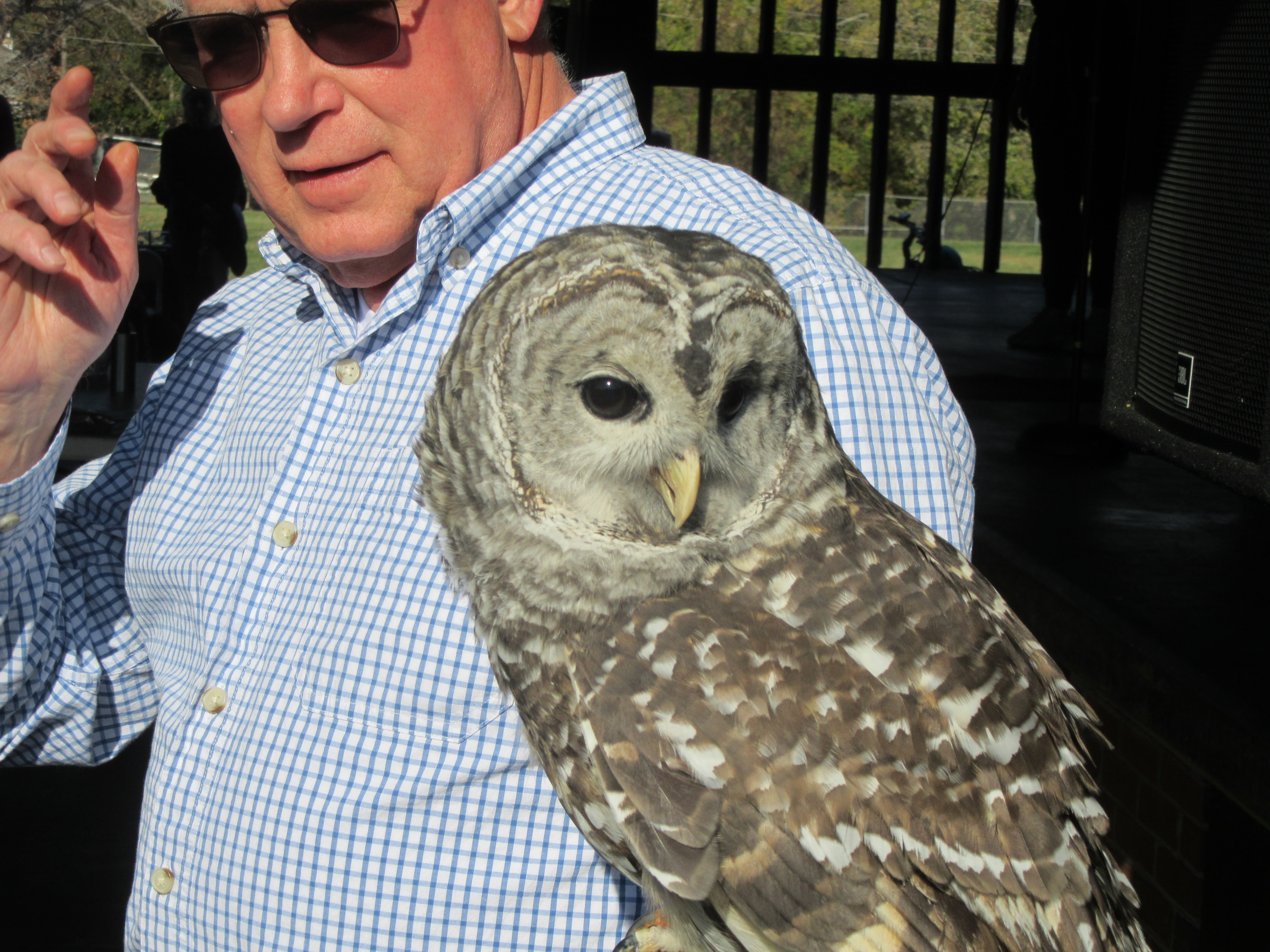Four owls, a red-shouldered hawk and an American kestrel mesmerized 400 doting human admirers who got up-close looks at these raptors on Nov. 5. People spilled out of Pavilion A at Fort Hunt Park on a balmy Sunday afternoon.
Liz and Tim Dennison from Secret Gardens Birds and Bees brought the birds to the park for a two-hour educational event sponsored by the Friends of Dyke Marsh and the National Park Service.
Raptors, also called birds of prey, have keen eyesight and hearing, sharp talons and a hooked beak. They typically eat meat. Diurnal raptors like hawks, eagles and vultures mostly hunt during the day. Nocturnal raptors like owls hunt at night. Many catch their prey with their feet.
Each of these birds was injured at some point and cannot survive on their own in the wild. The Dennisons have given each bird a name.
Pippin, an American kestrel, has two distinctive black vertical stripes on his face. The male kestrel has blue on the wings, but the female is mostly rusty brown, Liz Dennison explained. Someone found Pippin near Washington, D.C.’s National Mall, unafraid of people and appearing to beg for food. Because he had imprinted on people, he never learned to hunt or mate.
 Tim Dennison and a barred owl named Scarlet.
Tim Dennison and a barred owl named Scarlet.
Little Red, a red-shouldered hawk, is blind in his left eye, probably because a great horned owl grasped its head in an attack. These hawks, between 17 and 24 inches in length, often perch on tree branches or utility wires. In the wild, they eat small mammals, amphibians and reptiles. Also birds. One pair feasted on three of the Dennisons’ chickens, Liz said.
Scarlet, a female barred owl, has a damaged beak from a vehicular collision. Her caretakers have to trim this bird’s beak regularly which “she does not like,” Liz said. In the wild, barred owls hunt mice, frogs, bats, snakes and other animals. From 16 to 20 inches in length, they fly almost silently because of their velvety feathers.
Olive, a three-year-old perky barn owl, seemed to zero in on her fans. Barn owls have a distinctive white, heart-shaped face and are around 16 inches long. These owls hunt almost exclusively at night and are a favorite of farmers because they eat mice, Liz Dennison commented. One young barn owl can eat eight to ten mice a day. A family can scarf up 6,000 to 10,000 mice a year, she offered.
On the topic of mice, Dennison said, “There are no safe poisons.” A raptor that eats a mouse that has eaten rat poison will not survive. She recommended a “good snap trap” and consulting Raptors Are the Solution, an organization working to eliminate rodenticides.
Owls eat the whole animal Liz Dennison explained, but they cannot digest bones and fur. They don’t “poop them out,” she said. Instead, they regurgitate pellets, a clump of indigestible items. She once found a crow’s foot in a pellet.
Homer, the great horned owl, the largest owl at Fort Hunt that day, fixated on his many admirers with his big yellow eyes. His head tufts or plumicorns are not horns, Liz Dennison explained. Great horned owls are 18 to 25 inches in length, “at the top of the food chain,” she noted, and have a grip of 200 to 400 pounds per square inch. They can “carry away a five-pound chicken,” but she reassured, probably not a pet dog or cat. They may take over other birds’ nests and live 12 to 15 years in the wild.
Smaller but equally impressive, Little Voss, an eastern screech owl, about 10 inches in length, evoked many oohs and ahs and comments like, “He’s so cute!” Little Voss also has a damaged eye from a collision. Eastern screech owls are experts at camouflaging, blending into tree bark. They can even make themselves skinny, sit still and close their eyes to resemble a tree branch, Liz Dennison said.
The audience members, from one-year-olds to octogenarians, were totally enraptured by raptors.
More on Raptors
